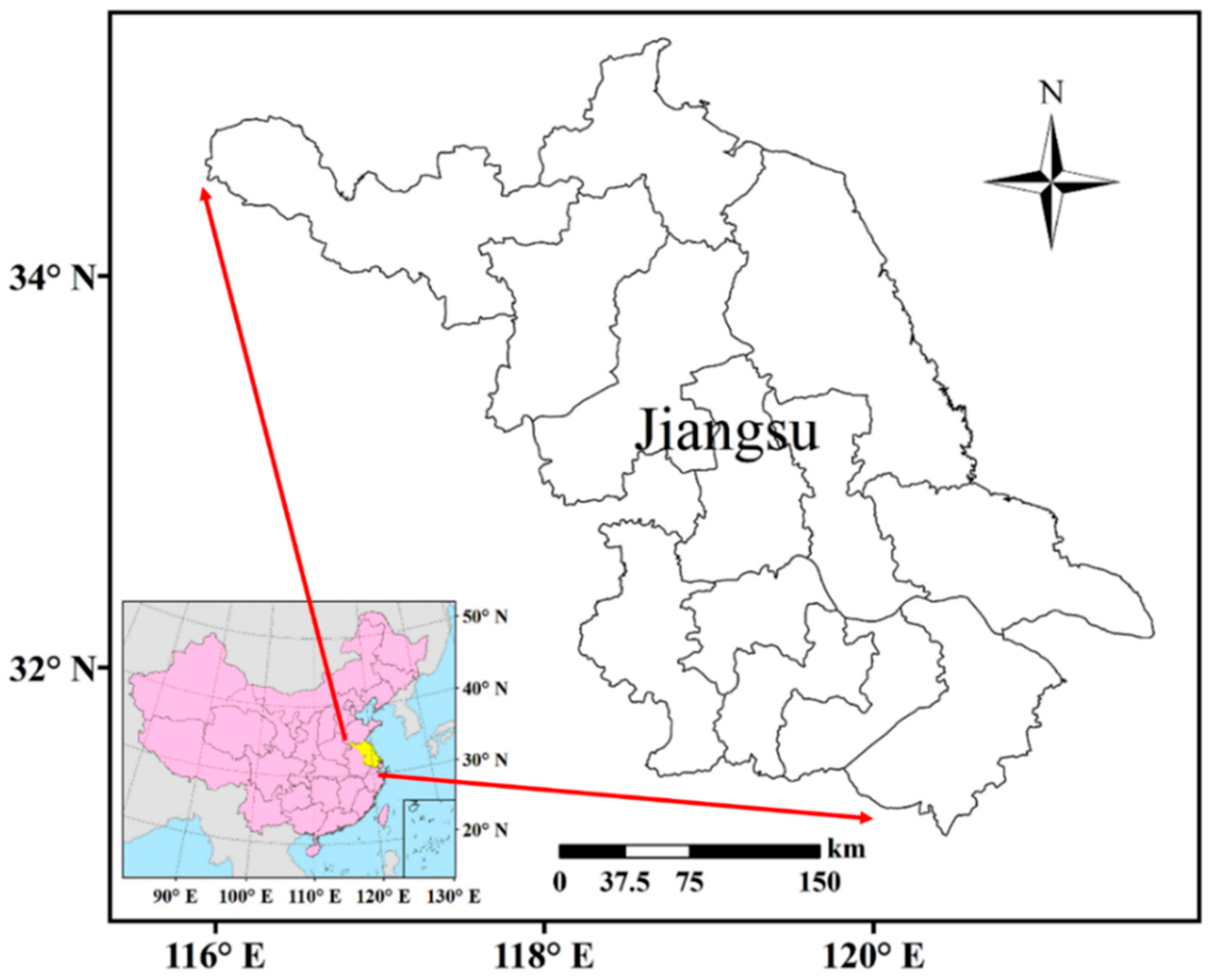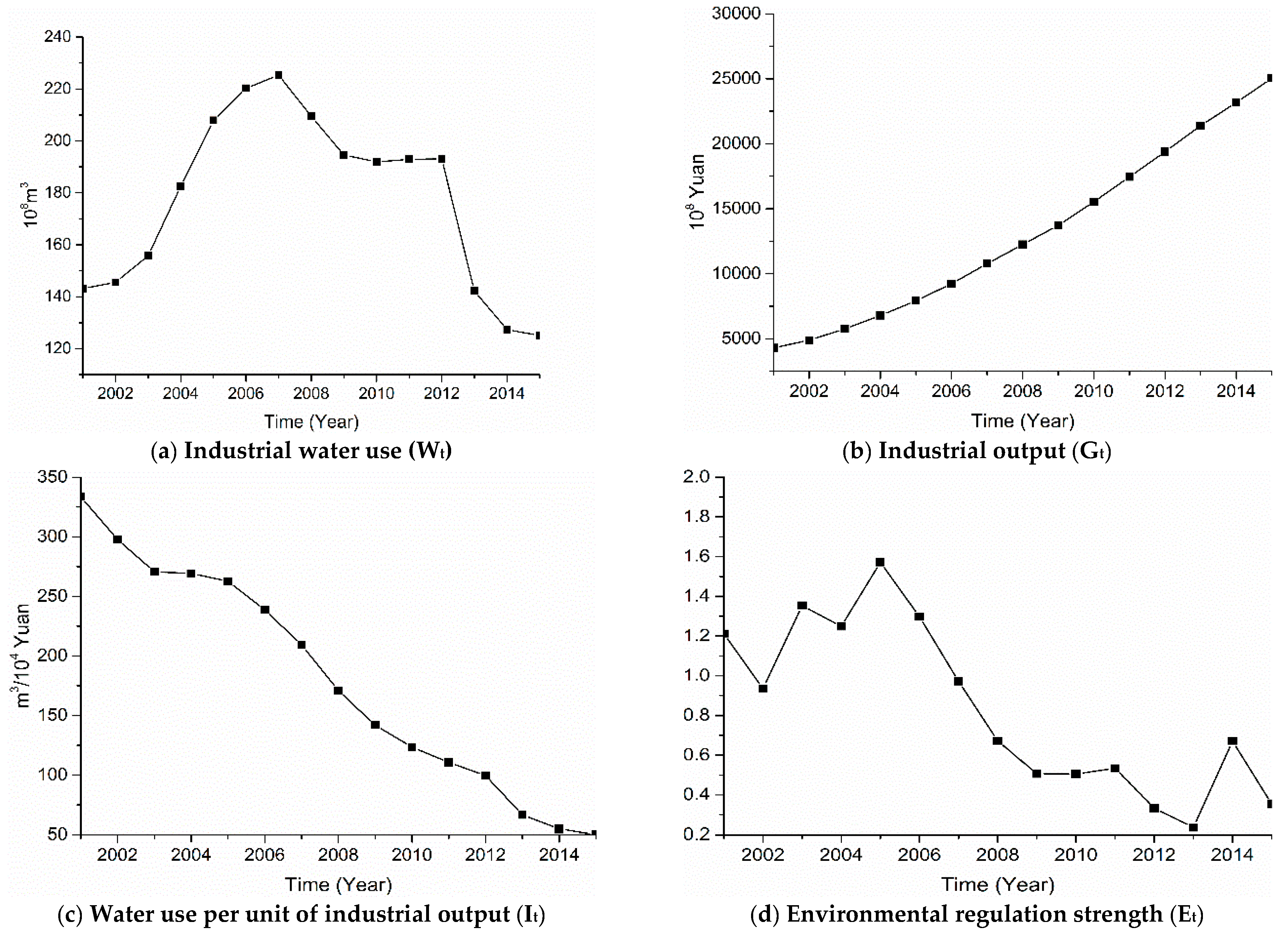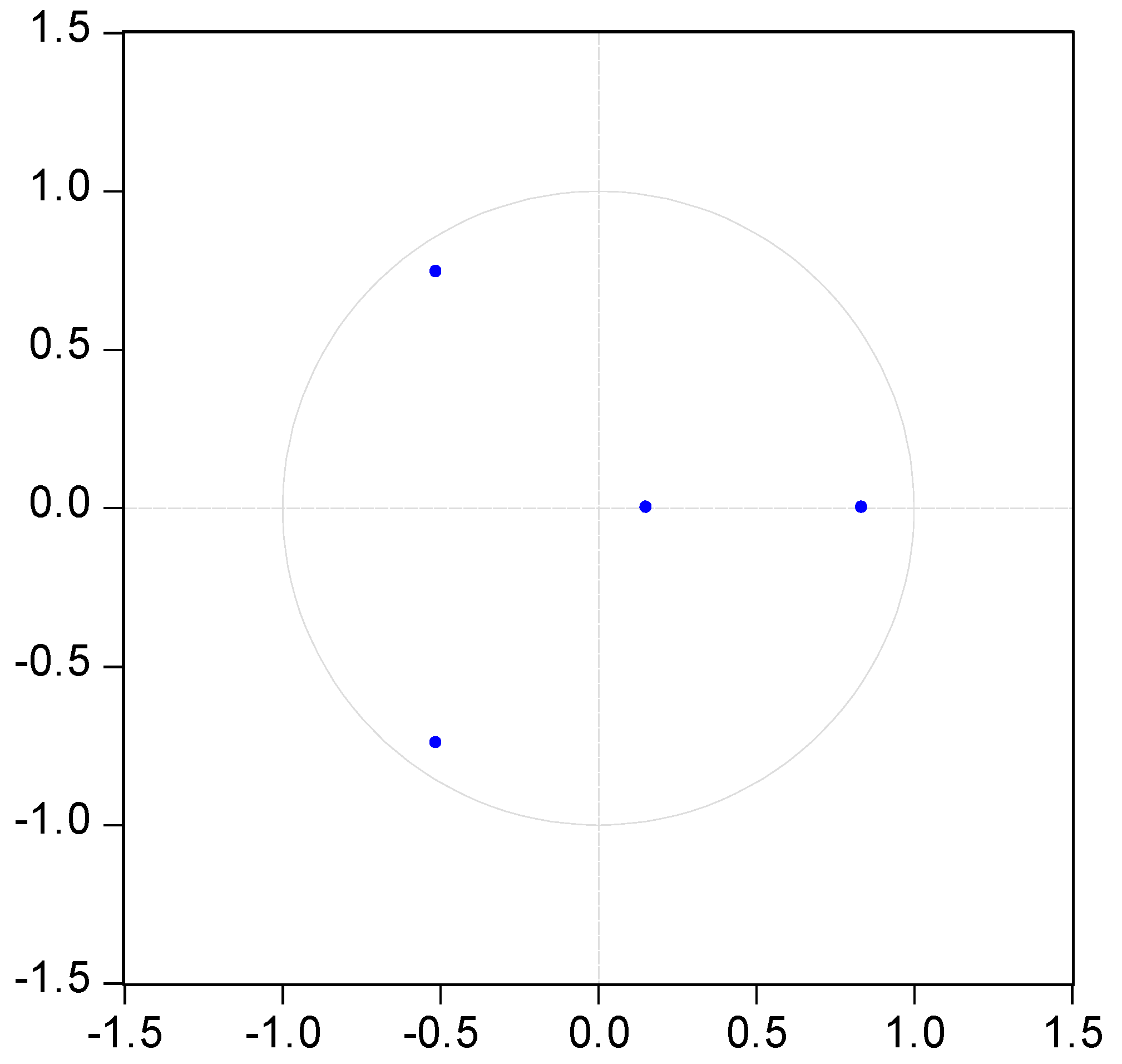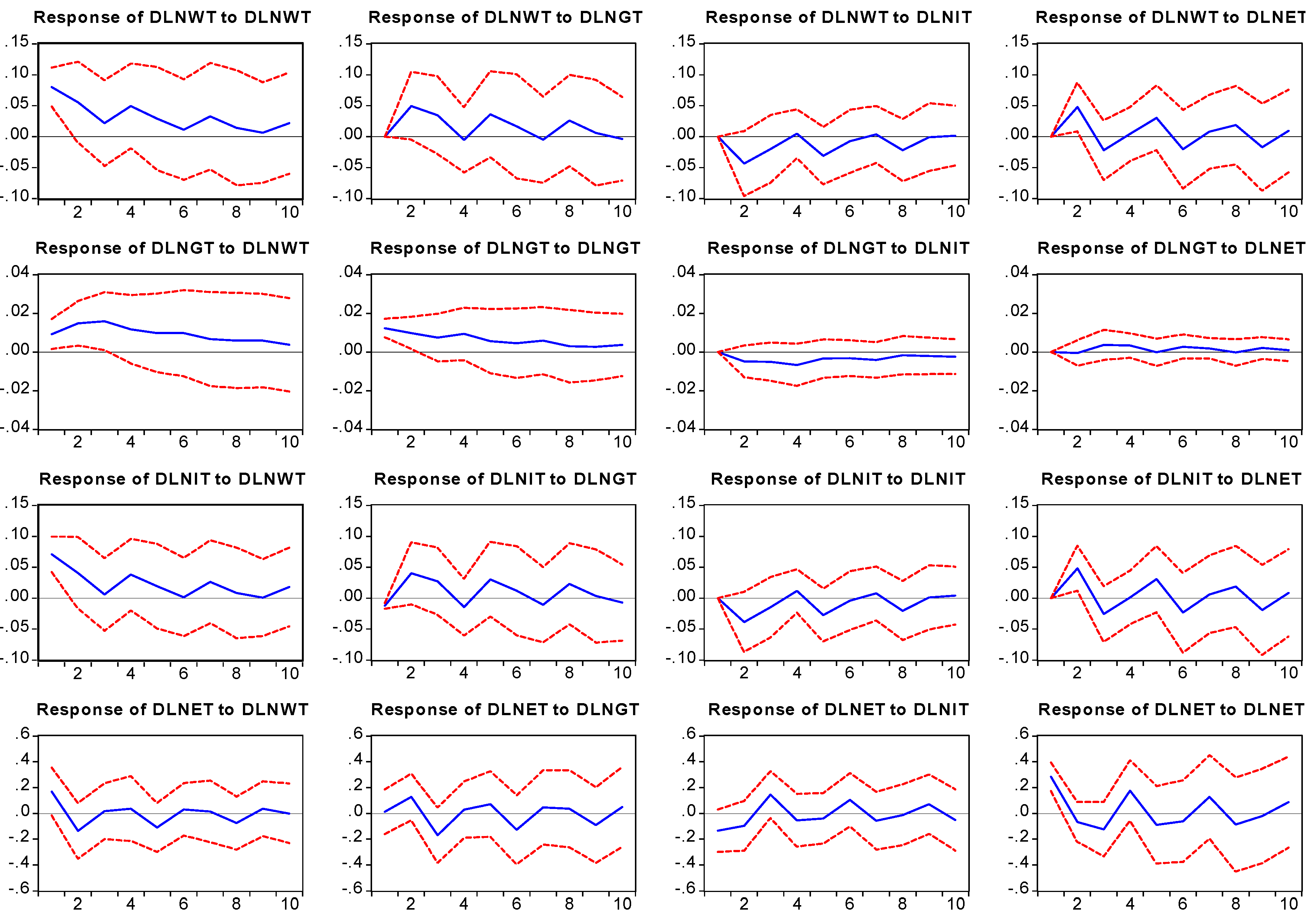An Empirical Research on Influence Factors of Industrial Water Use
Abstract
1. Introduction
2. Materials and Methods
2.1. Data
2.2. VAR Model
3. Results
3.1. Variable Description
3.2. The Unit Root Test Analysis
3.3. The Optimal Lag Order Analysis
3.4. Model Stability Test
3.5. Variance Decomposition Analysis
3.6. Impulse Response Analysis
4. Discussion
5. Conclusions
Author Contributions
Funding
Acknowledgments
Conflicts of Interest
References
- Dupont, D.P.; Renzetti, S. The Role of Water in Manufacturing. Environ. Resour. Econ. 2001, 18, 411–432. [Google Scholar] [CrossRef]
- Agana, B.A.; Reeve, D.; Orbell, J.D. An approach to industrial water conservation—A case study involving two large manufacturing companies based in Australia. J. Environ. Manag. 2013, 114, 445–460. [Google Scholar] [CrossRef] [PubMed]
- Reynaud, A. Assessing the impact of environmental regulation on industrial water use: Evidence from Brazil. Land Econ. 2005, 81, 396–411. [Google Scholar] [CrossRef]
- Davies, E.G.R.; Kyle, P.; Edmonds, J.A. An integrated assessment of global and regional water demands for electricity generation to 2095. Adv. Water Resour. 2013, 52, 296–313. [Google Scholar] [CrossRef]
- Brown, T.C.; Foti, R.; Ramirez, J.A. Projected freshwater withdrawals in the United States under a changing climate. Water Resour. Res. 2013, 49, 1259–1276. [Google Scholar] [CrossRef]
- Bijl, D.L.; Bogaart, P.W.; Kram, T.; Bijl, D.L.; Bogaart, P.W.; Kram, T.; De Vries, B.J.; Van Vuuren, D.P. Long-term water demand for electricity, industry and households. Environ. Sci. Policy 2016, 55, 75–86. [Google Scholar] [CrossRef]
- Vliet, M.T.H.V.; Wiberg, D.; Leduc, S.; Riahi, K. Power-generation system vulnerability and adaptation to changes in climate and water resources. Nat. Clim. Chang. 2016, 6, 375. [Google Scholar] [CrossRef]
- Qin, Y.; Curmi, E.; Kopec, G.M.; Allwood, J.M.; Richards, K.S. China’s energy-water nexus—Assessment of the energy sector’s compliance with the “3 Red Lines” industrial water policy. Energy Policy 2015, 82, 131–143. [Google Scholar] [CrossRef]
- Gu, A.; Teng, F.; Lv, Z. Exploring the nexus between water saving and energy conservation: Insights from industry sector during the 12th five-year plan period in china. Renew. Sustain. Energy Rev. 2016, 59, 28–38. [Google Scholar] [CrossRef]
- Van der Voorn, T.; Quist, J. Analysing the Role of Visions, Agency, and Niches in Historical Transitions in Watershed Management in the Lower Mississippi River. Water 2018, 10, 1845. [Google Scholar] [CrossRef]
- Wang, Z.; Deng, X.; Li, X.; Zhou, Q.; Yan, H. Impact analysis of government investment on water projects in the arid Gansu Province of China. Phys. Chem. Earth 2015, 79–82, 54–66. [Google Scholar] [CrossRef]
- Ministry of Water Resources of the People’s Republic of China. The 13th Five-Year Plan for Water Resources Development and Reform; Ministry of Water Resources of the People’s Republic of China: Beijing, China, 2016; (In Chinese).
- Shang, Y.; Wang, J.; Liu, J. Suitability analysis of China’s energy development strategy in the context of water resource management. Energy 2016, 96, 286–293. [Google Scholar] [CrossRef]
- Satoh, Y.; Kahil, M.T.; Byers, E.; Burek, P.; Fischer, G.; Tramberend, S.; Greve, P.; Flörke, M.; Eisner, S.; Hanasaki, N.; et al. Multi-model and multi-scenario assessments of asian water futures: The water futures and solutions (WFaS) initiative. Earths Future 2017, 5, 823–852. [Google Scholar] [CrossRef]
- Flörke, M.; Teichert, E.; Bärlund, I. Future changes of freshwater needs in European power plants. Manag. Environ. Qual. 2011, 22, 89–104. [Google Scholar] [CrossRef]
- Feeley, T.J.; Skone, T.J.; Stiegel, G.J.; McNemar, A.; Nemeth, M.; Schimmoller, B.; Murphy, J.T.; Manfredo, L. Water: A critical resource in the thermoelectric power industry. Energy 2008, 33, 1–11. [Google Scholar] [CrossRef]
- Boix, M.; Montastruc, L.; Pibouleau, L.; Azzaro-Pantel, C.; Domenech, S. Industrial water management by multiobjective optimization: From individual to collective solution through eco-industrial parks. J. Clean. Prod. 2012, 22, 85–97. [Google Scholar] [CrossRef]
- Gao, C.; Wang, D.; Dong, H.; Cai, J.; Zhu, W.; Du, T. Optimization and evaluation of steel industry’s water-use system. J. Clean. Prod. 2011, 19, 64–69. [Google Scholar] [CrossRef]
- Zhang, K.; Zhao, Y.; Cao, H.; Wen, H. Multi-scale water network optimization considering simultaneous intra- and inter-plant integration in steel industry. J. Clean. Prod. 2018, 176, 663–675. [Google Scholar] [CrossRef]
- Levidow, L.; Lindgaard-Jørgensen, P.; Nilsson, Å.; Skenhall, S.A.; Assimacopoulos, D. Process eco-innovation: Assessing meso-level eco-efficiency in industrial water-service systems. J. Clean. Prod. 2016, 110, 54–65. [Google Scholar] [CrossRef]
- Renzetti, S. Economic instruments and Canadian industrial water use. Can. Water Resour. J. 2005, 30, 21–30. [Google Scholar] [CrossRef]
- Flörke, M.; Kynast, E.; Bärlund, I.; Eisner, S.; Wimmer, F.; Alcamo, J. Domestic and industrial water uses of the past 60 years as a mirror of socio-economic development: A global simulation study. Glob. Environ. Chang. 2013, 23, 144–156. [Google Scholar] [CrossRef]
- Wang, X.-J.; Zhang, J.; Shahid, S.; Bi, S.-H.; Elmahdi, A.; Liao, C.-H.; Li, Y.-D. Forecasting industrial water demand in Huaihe river basin due to environmental changes. Mitig. Adapt. Strat. Glob. Chang. 2018, 23, 469–483. [Google Scholar] [CrossRef]
- Ali, B.; Kumar, A. Development of life cycle water-demand coefficients for coal-based power generation technologies. Energy Convers. Manag. 2015, 90, 247–260. [Google Scholar] [CrossRef]
- Yang, Z.; Xu, X.; Chen, W.; Wang, H. Dynamic structural decomposition analysis model of water use Evolution II: Application. J. Hydraul. Eng. 2015, 46, 802–810. (In Chinese) [Google Scholar] [CrossRef]
- York, R.; Rosa, E.A.; Dietz, T. STIRPAT, IPAT and ImPACT: Analytic tools for unpacking the driving forces of environmental impacts. Ecol. Econ. 2003, 46, 351–365. [Google Scholar] [CrossRef]
- Sun, C.Z.; Wang, Y. Driving force measurement of water utilization change in Liaoning Province and analysis of their spatial-temporal difference based on factor decomposition model. Arid Land Geogr. 2009, 32, 850–858. [Google Scholar] [CrossRef]
- Cazcarro, I.; Duarte, R.; Sánchez-Chóliz, J. Economic growth and the evolution of water consumption in Spain: A structural decomposition analysis. Ecol. Econ. 2013, 96, 51–61. [Google Scholar] [CrossRef]
- Shang, Y.; Lu, S.; Li, X.; Sun, G.; Shang, L.; Shi, H.; Lei, X.; Ye, Y.; Sang, X.; Wang, H. Drivers of industrial water use during 2003-2012 in Tianjin, China: A structural decomposition analysis. J. Clean. Prod. 2017, 140, 1136–1147. [Google Scholar] [CrossRef]
- Shang, Y.; Lu, S.; Shang, L.; Li, X.; Wei, Y.; Lei, X. Decomposition methods for analyzing changes of industrial water use. J. Hydrol. 2016, 543, 808–817. [Google Scholar] [CrossRef]
- Adomavicius, G.; Bockstedt, J.; Gupta, A. Modeling Supply-Side Dynamics of IT Components, Products, and Infrastructure: An Empirical Analysis Using Vector Autoregression. Inf. Syst. Res. 2012, 23, 397–417. [Google Scholar] [CrossRef]
- An, L.; Jin, X.; Ren, X. Are the macroeconomic effects of oil price shock symmetric? A factor-augmented vector autoregressive approach. Energy Econ. 2014, 45, 217–228. [Google Scholar] [CrossRef]
- Deng, Z.; Liu, Y.; Xue, H. Study on the Dynamic Relationship Between Economic Growth and Water Resources-Use Based on the VAR Model. Chin. J. Popul. Resour. Environ. 2012, 22, 128–135. (In Chinese) [Google Scholar]
- Jin, J.; Cui, Y.; Yang, Q.; Wu, C.; Pan, Z. Dynamic relationship analysis between total water consumption and water utilization structure in Shandong province based on the VAR model. J. Hydraul. Eng. 2015, 46, 551–557. (In Chinese) [Google Scholar] [CrossRef]
- Bagliano, F.C.; Morana, C. International macroeconomic dynamics: A factor vector autoregressive approach ? Econ. Model. 2009, 26, 432–444. [Google Scholar] [CrossRef]
- Sims, C.A. Macroeconomics and reality. Econometrica 1980, 48, 1–48. [Google Scholar] [CrossRef]
- Fu, J.; Li, L. A case study on the environmental regulation, the factor endowment and the international competitiveness in industries. Manag. World 2010, 4, 1582–1596. (In Chinese) [Google Scholar] [CrossRef]
- Xu, B.; Lin, B. Assessing CO2 emissions in China’s iron and steel industry: A dynamic vector autoregression model. Appl. Energy 2016, 161, 375–386. [Google Scholar] [CrossRef]
- Michieka, N.M.; Fletcher, J.; Burnett, W. An empirical analysis of the role of China’s exports on CO2 emissions. Appl. Energy 2013, 104, 258–267. [Google Scholar] [CrossRef]
- Nelson, C.R.; Plosser, C.R. Trends and random walks in macroeconmic time series: Some evidence and implications. J. Monet. Econ. 1982, 10, 139–162. [Google Scholar] [CrossRef]
- Dickey, D.A.; Fuller, W.A. Distribution of the estimators for autoregressive time series with a unit root. J. Am. Stat. Assoc. 1979, 74, 427–431. [Google Scholar] [CrossRef]
- Kwiatkowski, D.; Phillips, P.C.B.; Schmidt, P.; Shin, Y. Testing the null hypothesis of stationarity against the alternative of a unit root? How sure are we that economic time series have a unit root? J. Econom. 1992, 54, 159–178. [Google Scholar] [CrossRef]
- Perron, P. The great crash, the oil price shock, and the unit root hypothesis. Econometrica 1989, 57, 1361–1401. [Google Scholar] [CrossRef]
- Schwert, G.W. Tests for unit roots: A Monte Carlo investigation. J. Bus. Econ. Stat. 1989, 7, 147–159. [Google Scholar] [CrossRef]
- Sabuhoro, J.B.; Larue, B. The market efficiency hypothesis: The case of coffee and cocoa futures. Agric. Econ. 1997, 16, 171–184. [Google Scholar] [CrossRef][Green Version]
- Xu, B.; Lin, B. What cause a surge in China’s CO2 emissions? A dynamic vector autoregression analysis. J. Clean. Prod. 2017, 143, 17–26. [Google Scholar] [CrossRef]
- Peri, M.; Baldi, L. Vegetable oil market and biofuel policy: An asymmetric cointegration approach. Energy Econ. 2010, 32, 687–693. [Google Scholar] [CrossRef]
- Stock, J.H.; Watson, M.W. Vector autoregressions. J. Econ. Perspect. 2001, 15, 101–115. [Google Scholar] [CrossRef]
- Jiangsu Provincial Water Resources Department. Jiangsu Water Resources Bulletin [Online]. Available online: http://jswater.jiangsu.gov.cn/art/2017/7/5/art_51453_6179712.html (accessed on 10 April 2018).
- Hejazi, M.; Edmonds, J.; Clarke, L.; Kyle, P.; Davies, E.; Chaturvedi, V.; Wise, M.; Patel, P.; Eom, J.; Calvin, K.; et al. Long-term global water projections using six socioeconomic scenarios in an integrated assessment modeling framework. Technol. Forecasting Soc. Chang. 2014, 81, 205–226. [Google Scholar] [CrossRef]
- Zhang, X.; Liu, J.; Tang, Y.; Zhao, X.; Yang, H.; Gerbens-Leenes, P.W. China’s coal-fired power plants impose pressure on water resources. J. Clean. Prod. 2017, 161, 1171–1179. [Google Scholar] [CrossRef]
- Liu, L.; Hejazi, M.; Patel, P.; Kyle, P.; Davies, E.; Zhou, Y.; Edmonds, J. Water demands for electricity generation in the US: Modeling different scenarios for the water–energy nexus. Technol. Forecasting Soc. Chang. 2015, 94, 318–334. [Google Scholar] [CrossRef]
- Gao, L.; Hou, C.; Chen, Y.; Barrett, D.; Mallants, D.; Li, W.; Liu, R. Potential for mine water sharing to reduce unregulated discharge. J. Clean. Prod. 2016, 131, 133–144. [Google Scholar] [CrossRef]
- Mouratiadou, I.; Biewald, A.; Pehl, M.; Bonsch, M.; Baumstark, L.; Klein, D.; Popp, A.; Luderer, G.; Kriegler, E. The impact of climate change mitigation on water demand for energy and food: An integrated analysis based on the Shared Socioeconomic Pathways. Environ. Sci. Policy 2016, 64, 48–58. [Google Scholar] [CrossRef]
- Alkon, M.; He, X.; Paris, A.R.; Liao, W.; Hodson, T.; Wanders, N.; Wang, Y. Water security implications of coal-fired power plants financed through China’s Belt and Road Initiative. Energy Policy 2019, 132, 1101–1109. [Google Scholar] [CrossRef]




| Variable | Mean | Maximum | Minimum | Standard Deviation | |
|---|---|---|---|---|---|
| 177.14 | 225.3 | 125.1 | 34.07 | ||
| 159.76 | 335.22 | 44.68 | 94.99 | ||
| 13,171.48 | 25,305.37 | 4291.10 | 6888.49 | ||
| Wastewater discharge intensity | 21.22 | 45.36 | 8.86 | 11.95 | |
| SO2 emission intensity | 0.0050 | 0.0115 | 0.0012 | 0.0036 | |
| Dust emission intensity | 0.0029 | 0.0072 | 0.0008 | 0.0023 | |
| Variable | Definition | Units of Measure |
|---|---|---|
| The annual amount of industrial water use | 108 m3 | |
| Water use per unit of industrial output | m3·10−4 yuan | |
| Industrial output | 108 yuan | |
| Integrated indicator of industrial wastewater discharge, industrial sulfur dioxide emission, and dust emission intensities | tons·10−4 yuan |
| Variable | ADF | PP | KPSS | |||
|---|---|---|---|---|---|---|
| LnWt | (c, 0, 1) | 0.3886 | (0, 0, 2) | −0.2799 | (c, t, 2) | 0.1608 ** |
| DLnWt | (0, 0, 0) | −2.0363 ** | (0, 0, 2) | −2.0363 ** | (c, t, 2) | 0.0814 |
| LnGt | (c, 0, 0) | −5.9871 *** | (c, 0, 0) | −5.9871 *** | (c, t, 2) | 0.1683 ** |
| DLnGt | (c, t, 0) | −5.4543 *** | (c, t, 2) | −6.9820 *** | (c, t, 2) | 0.1315 * |
| LnIt | (c, t, 0) | −1.2753 | (c, t, 2) | −1.1784 | (c, t, 2) | 0.1559 ** |
| DLnIt | (c, t, 1) | −3.9786 ** | (c, t, 12) | −3.7376 * | (c, t, 2) | 0.0847 |
| LnEt | (c, t, 0) | −2.8113 | (c, t, 3) | −2.7236 | (c, 0, 2) | 0.5080 ** |
| DLnEt | (c, t, 0) | −4.8098 *** | (c, 0, 2) | −4.9289 *** | (c, 0, 2) | 0.1192 |
| Lag | LogL | LR | FRE | AIC | SC | HQ |
|---|---|---|---|---|---|---|
| 0 | 139.2350 | NA | 1.08 × 10−14 | −20.80538 | −20.63155 | −20.84111 |
| 1 | 170.8913 | 38.96,165 * | 1.15 × 10−15 * | −23.21405 * | −22.34489 * | −23.39270 * |
| Period | S.E. | ||||
|---|---|---|---|---|---|
| 1 | 0.080185 | 100.0000 | 0.000000 | 0.000000 | 0.000000 |
| 2 | 0.127087 | 58.90791 | 15.30284 | 11.59534 | 14.19392 |
| 3 | 0.136670 | 53.47121 | 19.58484 | 12.10484 | 14.83911 |
| 4 | 0.145645 | 58.69928 | 17.36662 | 10.77795 | 13.15616 |
| 5 | 0.158871 | 52.67770 | 19.75646 | 12.79561 | 14.77023 |
| 6 | 0.161609 | 51.40966 | 20.14291 | 12.57893 | 15.86850 |
| 7 | 0.165227 | 53.14265 | 19.36203 | 12.07962 | 15.41570 |
| 8 | 0.170317 | 50.70844 | 20.58523 | 13.01690 | 15.68943 |
| 9 | 0.171401 | 50.21471 | 20.45792 | 12.85544 | 16.47193 |
| 10 | 0.173073 | 50.83091 | 20.10459 | 12.61742 | 16.44708 |
© 2019 by the authors. Licensee MDPI, Basel, Switzerland. This article is an open access article distributed under the terms and conditions of the Creative Commons Attribution (CC BY) license (http://creativecommons.org/licenses/by/4.0/).
Share and Cite
Wang, B.; Wang, X.; Zhang, X. An Empirical Research on Influence Factors of Industrial Water Use. Water 2019, 11, 2267. https://doi.org/10.3390/w11112267
Wang B, Wang X, Zhang X. An Empirical Research on Influence Factors of Industrial Water Use. Water. 2019; 11(11):2267. https://doi.org/10.3390/w11112267
Chicago/Turabian StyleWang, Bingxuan, Xiaojun Wang, and Xu Zhang. 2019. "An Empirical Research on Influence Factors of Industrial Water Use" Water 11, no. 11: 2267. https://doi.org/10.3390/w11112267
APA StyleWang, B., Wang, X., & Zhang, X. (2019). An Empirical Research on Influence Factors of Industrial Water Use. Water, 11(11), 2267. https://doi.org/10.3390/w11112267






